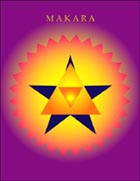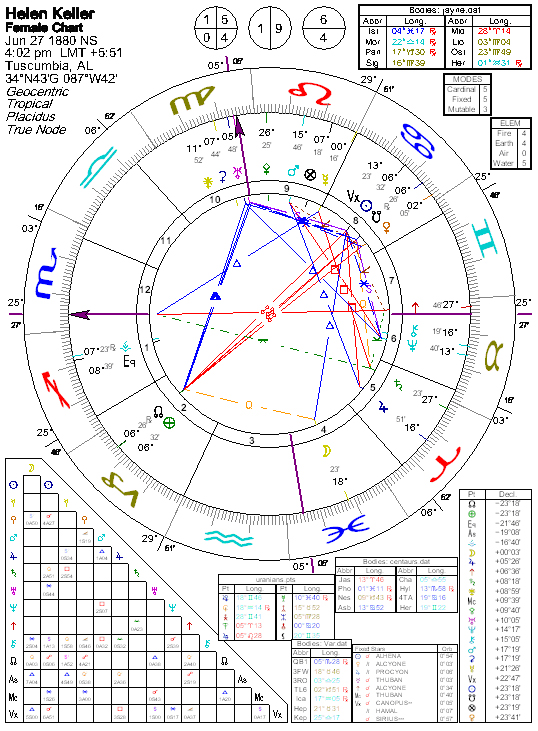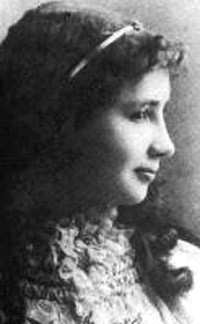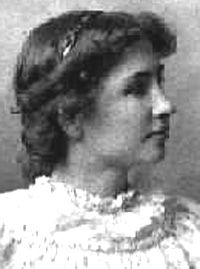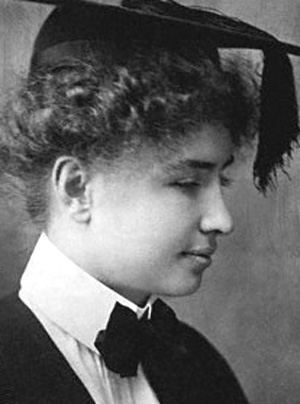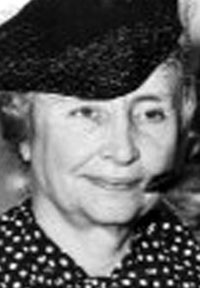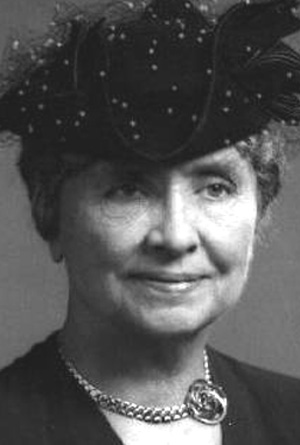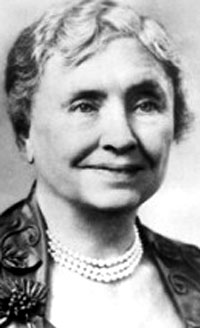Helen Keller
Michael D. Robbins
© 2002
Astro-Rayological
Interpretation & Charts
Quotes
Biography
Images and Physiognomic Interpretation
Helen Keller
—Author, Educator: June 27, 1880, Tuscumbia, Alabama, 4:00 PM, LMT. (Source: Sabian Symbols, and Famous Nativities. According to LMR, Ruth Dewey quotes Wemyss Astrological Quarterly 12/1930; there is conflicting data.) Died, June 1, 1968, Westport, Connecticut, USA.
Ascendant, Scorpio; MC in Virgo with Uranus in Virgo conjunct the MC; Sun conjunct Venus in Cancer; Moon in Pisces; Mercury and Mars in Leo; Jupiter and Mars in Aries; Neptune and Pluto in Taurus with Pluto conjunct the DSC.
Although the world is full of suffering, it is also full of the overcoming of it.
(Chiron conjunct Neptune.)Avoiding danger is no safer in the long run than outright exposure. The fearful are caught as often as the bold.
Be not dumb, obedient slaves in an army of destruction! Be heroes in an army of construction!
(Pluto in Taurus conjunct Descendant)Death is no more than passing from one room into another. But there's a difference for me, you know. Because in that other room I shall be able to see.
Everything has its wonders, even darkness and silence, and I learn, whatever state I may be in, therein to be content.
Faith is the strength by which a shattered world shall emerge into the light.
I do not want the peace which passeth understanding, I want the understanding which bringeth peace.
I long to accomplish a great and noble task, but it is my chief duty to accomplish small tasks as if they were great and noble.
I seldom think about my limitations, and they never make me sad. Perhaps there is just a touch of yearning at times; but it is vague, like a breeze among flowers.
It is a terrible thing to see and have no vision.
It is for us to pray not for tasks equal to our powers, but for powers equal to our tasks, to go forward with a great desire forever beating at the door of our hearts as we travel toward our distant goal.
(Scorpio Ascendant)It is wonderful how much time good people spend fighting the devil. If they would only expend the same amount of energy loving their fellow men, the devil would die in his own tracks of ennui.
Knowledge is love and light and vision.
(Venus conjunct Sun)Life is an exciting business, and most exciting when it is lived for others.
Many people know so little about what is beyond their short range of experience. They look within themselves - and find nothing! Therefore they conclude that there is nothing outside themselves either.
Many persons have a wrong idea of what constitutes true happiness. It is not attained through self-gratification but through fidelity to a worthy purpose.
(Mars in Leo square Neptune & Chiron)My share of the work may be limited, but the fact that it is work makes it precious.
Never bend your head. Always hold it high. Look the world straight in the eye.
One can never consent to creep when one feels an impulse to soar.
Optimism is the faith that leads to achievement. Nothing can be done without hope and confidence.
(Jupiter in Aries in 5th house trine Mars in Leo)Science may have found a cure for most evils; but it has found no remedy for the worst of them all - the apathy of human beings.
Security is mostly a superstition. It does not exist in nature, nor do the children of men as a whole experience it. Avoiding danger is no safer in the long run than outright exposure. Life is either a daring adventure, or nothing.
(Sun, Venus & South Node in Cancer. Uranus conjunct MC.)Smell is a potent wizard that transports you across thousands of miles and all the years you have lived.
Strike against war, for without you no battles can be fought!
The highest result of education is tolerance.
The marvelous richness of human experience would lose something of rewarding joy if there were no limitations to overcome. The hilltop hour would not be half so wonderful if there were no dark valleys to traverse.
(Scorpio Ascendant)The world is moved along, not only by the mighty shoves of its heroes, but also by the aggregate of tiny pushes of each honest worker.
What we have once enjoyed we can never lose. All that we love deeply becomes a part of us.
(Moon in Pisces)When one door closes, another opens. But we often look so regretfully upon the closed door that we don't see the one that has opened for us.
I sometimes wonder if the hand is not more sensitive to the beauties of sculpture than the eye. I should think the wonderful rhythmical flow of lines and curves could be more subtly felt than seen. Be this as it may, I know that I can feel the heart- throbs of the ancient Greeks in their marble gods and goddesses.
Museums and art stores are also sources of pleasure and inspiration. Doubtless it will seem strange to many that the hand unaided by sight can feel action, sentiment, beauty in the cold marble; and yet it is tr Literature is my utopia.
The best educated human being is the one who understands most about the life in which he is placed.
A man can't make a place for himself in the sun if he keeps taking refuge under the family tree.
(Cancer Sun?!)There is no better way to thank God for your sight than by giving a helping hand to someone in the dark.
(Chiron conjunct Neptune in 6th house)I believe in the immortality of the soul because I have within me immortal longings
There is plenty of courage among us for the abstract but not for the concrete.
I am just as deaf as I am blind. The problems of deafness are deeper and more complex, if not more important than those of blindness. Deafness is a much worse misfortune. For it means the loss of the most vital stimulus -- the sound of the voice that brings language, sets thoughts astir, and keeps us in the intellectual company of man.
Helen Adams Keller
June 27, 1880 – June 1, 1968) was a deafblind American author, activist and lecturer.
All below has been excerpted from public online sources and compiled here for reference.
Deaf-blind American author, activist, and lecturer
Born June 27, 1880
Tuscumbia, Alabama, USA
Died June 1, 1968
Easton, Connecticut, USA
Keller was born at an estate called Ivy Green in Tuscumbia, Alabama, on June 27, 1880, to parents Captain Arthur H. Keller and Kate Adams Keller. She was not born blind and deaf; it was not until nineteen months of age that she came down with an illness described by doctors as "an acute congestion of the stomach and the brain", which could have possibly been scarlet fever or meningitis. The illness did not last for a particularly long time, but it left her deaf and blind. By age seven she had invented over sixty different signs that she could use to communicate with her family.In 1886, her mother Kate Keller was inspired by an account in Charles Dickens' American Notes of the successful education of another deaf/blind child, Laura Bridgman, and travelled to a specialist doctor in Baltimore for advice. He put her in touch with local expert Alexander Graham Bell, who was working with deaf children at the time. Bell advised the couple to contact the Perkins Institute for the Blind, the school where Bridgman had been educated, which was then located in South Boston, Boston, Massachusetts. The school delegated teacher and former student, Anne Sullivan, herself visually impaired and then only 20 years old, to become Helen's teacher. It was the beginning of a 49-year-long relationship.
Sullivan got permission from Helen's father to isolate the girl from the rest of the family in a little house in their garden. Her first task was to instill discipline in the spoiled girl. Helen's big breakthrough in communication came one day when she realized that the motions her teacher was making on her palm, while running cool water over her palm from a pump, symbolized the idea of "water"; she then nearly exhausted Sullivan demanding the names of all the other familiar objects in her world (including her prized doll).
In 1890, ten-year-old Helen Keller was introduced to the story of Ragnhild Kaata - a deafblind Norwegian girl who had learned to speak. Ragnhild Kaata's success inspired Helen - she wanted to learn to speak as well. Anne was able to teach Helen to speak using the Tadoma method (touching the lips and throat of others as they speak) combined with "fingerspelling" alphabetical characters on the palm of Helen's hand. Later, Keller would also learn to read English, French, German, Greek, and Latin in Braille.
In 1888, Helen attended the Perkins School for the Blind. In 1894, Helen and Anne moved to New York City to attend the Wright-Humason School for the Deaf. In 1898 they returned to Massachusetts and Helen entered The Cambridge School for Young Ladies before gaining admittance, in 1900, to Radcliffe College. In 1904 at the age of 24, Helen graduated from Radcliffe magna cum laude, becoming the first deaf and blind person to graduate from a college.
When Keller visited Akita Prefecture in Japan in July 1937, she inquired about Hachiko, the famed Akita dog that had died in 1935. She expressed to a local that she would like to have an Akita dog. An Akita called Kamikaze-go was given to her within a month. When Kamikaze-go later died (at a young age) because of canine distemper, his older brother, Kenzan-go, was presented to her as an official gift from the Japanese government in July 1939.
Keller is credited with having introduced the Akita to America through Kamikaze-go and his successor, Kenzan-go. By 1938 a breed standard had been established and dog shows had been held, but such activities stopped after World War II began.
Keller wrote in the Akita Journal: "If ever there was an angel in fur, it was Kamikaze. I know I shall never feel quite the same tenderness for any other pet. The Akita dog has all the qualities that appeal to me — he is gentle, companionable and trusty."
Helen went on to become a world-famous speaker and author. She is remembered as an advocate for the sensorially handicapped, but also supported progressive causes. She was a suffragist, a pacifist and a birth control supporter. In 1915 she founded Helen Keller International, a non-profit organization for preventing blindness. Helen and Anne Sullivan traveled all over the world to over 39 countries, and made several trips to Japan, becoming a favorite of the Japanese people. Helen Keller met every U.S. President from Grover Cleveland to Lyndon B. Johnson and was friends with many famous figures including Alexander Graham Bell, Charlie Chaplin and Mark Twain.
Helen Keller was a member of the Socialist Party and actively campaigned and wrote in support of the working classes from 1909 to 1921. She supported Socialist Party candidate Eugene V. Debs in each of his campaigns for the presidency. Her political views were reinforced by visiting workers. In her words, "I have visited sweatshops, factories, crowded slums. If I could not see it, I could smell it."
Newspaper columnists who had praised her courage and intelligence before she came out as a socialist now called attention to her disabilities. The editor of the Brooklyn Eagle wrote that her "mistakes sprung out of the manifest limitations of her development." Keller responded to that editor, referring to having met him before he knew of her political views:
"At that time the compliments he paid me were so generous that I blush to remember them. But now that I have come out for socialism he reminds me and the public that I am blind and deaf and especially liable to error. I must have shrunk in intelligence during the years since I met him...Oh, ridiculous Brooklyn Eagle! Socially blind and deaf, it defends an intolerable system, a system that is the cause of much of the physical blindness and deafness which we are trying to prevent."
Helen Keller also joined the famous labor union, the Industrial Workers of the World (IWW), in 1912 after she felt that parliamentary socialism was "sinking in the political bog." Helen Keller wrote for the IWW between 1916 and 1918. In "Why I Became an IWW," Helen wrote that her motivation for activism came in part due to her concern about blindness and other disabilities:
"I was appointed on a commission to investigate the conditions of the blind. For the first time I, who had thought blindness a misfortune beyond human control, found that too much of it was traceable to wrong industrial conditions, often caused by the selfishness and greed of employers. And the social evil contributed its share. I found that poverty drove women to a life of shame that ended in blindness."
Writings
In 1960, her book Light in my Darkness was published in which she advocated the teachings of the Swedish scientist and philosopher Emanuel Swedenborg. She also wrote a lengthy autobiography called The Story of My Life. She wrote a total of eleven books, and authored numerous articles.On September 14, 1964, President Lyndon B. Johnson awarded her the Presidential Medal of Freedom, the United States' highest civilian honor.
The state of Alabama honored Keller — a native of the state — on its state quarter. The Helen Keller Hospital was also dedicated to her.
Keller devoted much of her later life to raise funds for the American Foundation for the Blind.
Helen Keller died on June 1, 1968, at the age of 87 from natural causes at 3:35 P.M. in Arcan Ridge, Easton, Connecticut, more than 30 years after the death of Anne Sullivan, and was cremated in Bridgeport, Connecticut. Some sources, including an obituary in The New York Times, mistakenly said she died in Westport, Connecticut. The confusion arose from her use of a Westport postal box for her Arcan Ridge estate. Easton, which did not have a post office at the time, has named a middle school after one of its most famous residents. Her memorial service was at Washington National Cathedral, where she was buried. Her tomb is located in the rear of the St. Joseph's Chapel on the Crypt level of the Cathedral.
A silent film, Deliverance (not to be mistaken for the other, much later and more famous movie Deliverance which is irrelevant to Keller) first told Keller's story. The Miracle Worker, a play about how Helen Keller learned to communicate, was made into a movie three times. The 1962 version of the movie won Academy Awards for Best Actress in a Leading Role for Anne Bancroft who played Sullivan and Best Actress in a Supporting Role for Patty Duke who played Keller.
Another recent film about Helen Keller's life is The Miracle Continues. This semi-sequel to The Miracle Worker recounts her college years and her early adult life. None of the early movies hint at the social activism that would become the hallmark of Helen's later life, although the The Walt Disney Company version produced in 2000 states in the credits that Helen became an activist for social equality.
The story of Helen Keller is the story of a child who, at the age of 19 months, suddenly lost her hearing and vision, and who, against overwhelming odds and with a great deal of persistence, grew into a highly intelligent and sensitive woman who wrote, spoke, and labored incessantly for the betterment of others. So powerful a symbol of triumph over adversity did she become that she has a definite place in the history of our time and of times to come.
Helen Adams Keller was born a healthy child in Tuscumbia, Alabama, U.S. on June 27, 1880 in a white, frame cottage called "Ivy Green." On her father's side she was descended from Alexander Spottswood, a colonial governor of Virginia, who was connected with the Lees and other Southern families. On her mother's side, she was related to a number of prominent New England families, including the Hales, the Everetts, and the Adamses. Her father, Captain Arthur Keller, was the editor of a newspaper, the North Alabamian. Captain Keller also had a strong interest in public life and was an influential figure in his own community. In 1885, under the Cleveland administration, he was appointed Marshal of North Alabama.
The illness that struck the infant Helen Keller, and left her deaf and blind before she learned to speak, was diagnosed as brain fever at the time; perhaps it was scarlet fever. As Helen Keller grew from infancy into childhood she was wild and unruly, and had little real understanding of the world around her.
Helen Keller's new life began on a March day in 1887 when she was a few months short of seven years old. On that day, which Miss Keller was always to call "The most important day I can remember in my life," Anne Mansfield Sullivan came to Tuscumbia to be her teacher. Miss Sullivan, a 20-year-old graduate of the Perkins School for the Blind, who had regained useful sight through a series of operations, had come to the Kellers through the sympathetic interest of Alexander Graham Bell. From that fateful day, the two—teacher and pupil—were inseparable until the death of the former in 1936.
How Miss Sullivan turned the uncontrolled child into a responsible human being and succeeded in awakening and stimulating her marvelous mind is familiar to millions, most notably through William Gibson's play and film, The Miracle Worker, Miss Keller's autobiography of her early years, The Story of My Life, and Joseph Lash's Helen and Teacher.
Miss Sullivan began her task with a doll that the children at Perkins had made for her to take to Helen. By spelling "d-o-l-l" into the child's hand, she hoped to teach her to connect objects with letters. Helen quickly learned to form the letters correctly and in the correct order, but did not know she was spelling a word, or even that words existed. In the days that followed she learned to spell a great many more words in this uncomprehending way.
One day she and "Teacher"—as Helen always called her—went to the outdoor pump. Miss Sullivan started to draw water and put Helen's hand under the spout. As the cool water gushed over one hand, she spelled into the other hand the word "w-a-t-e-r" first slowly, then rapidly. Suddenly, the signals had meaning in Helen's mind. She knew that "water" meant the wonderful cool substance flowing over her hand. Quickly, she stopped and touched the earth and demanded its letter name and by nightfall she had learned 30 words.
Thus began Helen Keller's education. She proceeded quickly to master the alphabet, both manual and in raised print for blind readers, and gained facility in reading and writing. In 1890, when she was just 10, she expressed a desire to learn to speak. Somehow she had found out that a little deaf-blind girl in Norway had acquired that ability. Miss Sarah Fuller of the Horace Mann School was her first speech teacher.
Even when she was a little girl, Helen Keller said, "Someday I shall go to college." And go to college she did. In 1898 she entered the Cambridge School for Young Ladies to prepare for Radcliffe College. She entered Radcliffe in the fall of 1900 and received her bachelor of arts degree cum laude in 1904. Throughout these years and until her own death in 1936, Anne Sullivan was always by Helen's side, laboriously spelling book after book and lecture after lecture, into her pupil's hand.
Helen Keller's formal schooling ended when she received her B.A. degree, but throughout her life she continued to study and stay informed on all matters of importance to modern people. In recognition of her wide knowledge and many scholarly achievements, she received honorary doctoral degrees from Temple University and Harvard University and from the Universities of Glasgow, Scotland; Berlin, Germany; Delhi, India; and Witwatersrand in Johannesburg, South Africa. She was also an Honorary Fellow of the Educational Institute of Scotland.
Anne Sullivan's marriage, in 1905, to John Macy, an eminent critic and prominent socialist, caused no change in the teacher-pupil relationship. Helen went to live with the Macys and both husband and wife unstintingly gave their time to help her with her studies and other activities.
While still a student at Radcliffe, Helen Keller began a writing career that was to continue on and off for 50 years. In 1903, The Story of My Life, which had first appeared in serial form in the Ladies Home Journal, appeared in book form. This was always to be the most popular of her works and today is available in more than 50 languages, including Marathi, Pushtu, Tagalog, and Vedu. It is also available in several paperback editions in the United States.
Miss Keller's other published works include Optimism, an essay; The World I Live In; The Song of the Stone Wall; Out of the Dark; My Religion; Midstream—My Later Life; Peace at Eventide; Helen Keller in Scotland; Helen Keller's Journal; Let Us Have Faith; Teacher, Anne Sullivan Macy; and The Open Door.
In addition, she was a frequent contributor to magazines and newspapers, writing most frequently on blindness, deafness, socialism, social issues, and women's rights. She used a braille typewriter to prepare her manuscripts and then copied them on a regular typewriter.
During her lifetime, Helen Keller received awards of great distinction too numerous to recount fully here. An entire room, called the Helen Keller Archives at the American Foundation for the Blind in New York City, is devoted to their preservation. These awards include Brazil's Order of the Southern Cross; Japan's Sacred Treasure; the Philippines' Golden Heart; Lebanon's Gold Medal of Merit; and her own country's highest honor, the Presidential Medal of Freedom. Most of these awards were bestowed on her in recognition of the stimulation her example and presence gave to work for the blind in those countries. In 1933 she was elected to membership in the National Institute of Arts and Letters. During the Louis Braille Centennial Commemoration in 1952, Miss Keller was made a Chevalier of the French Legion of Honor at a ceremony in the Sorbonne.
On the 50th anniversary of her graduation, Radcliffe College granted her its Alumnae Achievement Award. Her Alma Mater also showed its pride in her by dedicating the Helen Keller Garden in her honor and by naming a fountain in the garden for Anne Sullivan Macy.
Miss Keller also received the Americas Award for Inter-American Unity, the Gold Medal Award from the National Institute of Social Sciences, the National Humanitarian Award from Variety Clubs International, and many others. She held honorary memberships in scientific societies and philanthropic organizations throughout the world.
Yet another honor came to Helen Keller in 1954 when her birthplace, "Ivy Green," in Tuscumbia, was made a permanent shrine. It was dedicated on May 7, 1954 with officials of the American Foundation for the Blind and many other agencies and organizations present. In conjunction with this event, the premiere of Miss Keller's film biography, "The Unconquered," produced by Nancy Hamilton and narrated by Katharine Cornell, was held in the nearby city of Birmingham. The film was later renamed "Helen Keller in Her Story" and in 1955 won an "Oscar"—the Academy of Motion Picture Arts and Sciences award as the best feature-length documentary film of the year.
Miss Keller was indirectly responsible for two other "Oscars" a few years later when Anne Bancroft and Patty Duke won them for their portrayals of Anne Sullivan and Helen Keller in the film version of "The Miracle Worker."
More rewarding to her than the many honors she received were the acquaintances and friendships Helen Keller made with most of the leading personalities of her time. She met many world figures, from Grover Cleveland to Charlie Chaplin, Nehru, and John F. Kennedy. Among those she met, she counted many personal friends including Katharine Cornell, Van Wyck Brooks, Alexander Graham Bell, and Jo Davidson. Two friends from her early youth, Mark Twain and William James, expressed beautifully what most of her friends felt about her. Mark Twain said, "The two most interesting characters of the 19th century are Napoleon and Helen Keller." William James wrote, "But whatever you were or are, you're a blessing!"
As broad and wide ranging as her interests were, Helen Keller never lost sight of the needs of other blind and deaf-blind individuals. From her youth, she was always willing to help them by appearing before legislatures, giving lectures, writing articles, and above all, by her own example of what a severely disabled person could accomplish. When the American Foundation for the Blind, the national clearinghouse for information on blindness, was established in 1921, she at last had an effective national outlet for her efforts. From 1924 until her death she was a member of the Foundation staff, serving as counselor on national and international relations. It was also in 1924 that Miss Keller began her campaign to raise the "Helen Keller Endowment Fund" for the Foundation. Until her retirement from public life, she was tireless in her efforts to make the Fund adequate for the Foundation's needs.
Of all her contributions to the Foundation, Miss Keller was perhaps most proud of her assistance in the formation in 1946 of its special service for deaf-blind persons. She was, of course, deeply concerned for this group of people and was always searching for ways to help those "less fortunate than myself."
Helen Keller was as interested in the welfare of blind persons in other countries as she was for those in her own country; conditions in the underdeveloped and war-ravaged nations were of particular concern. Her active participation in this area of work for the blind began as early as 1915 when the Permanent Blind War Relief Fund, later called the American Braille Press, was founded. She was a member of its first board of directors.
When the American Braille Press became the American Foundation for Overseas Blind (now Helen Keller International) in 1946, Miss Keller was appointed counselor on international relations. It was then that she began the globe-circling tours on behalf of the blind for which she was so well known during her later years. During seven trips between 1946 and 1957 she visited 35 countries on five continents. In 1955, when she was 75 years old, she embarked on one of her longest and most grueling journeys, a 40,000-mile, five-month-long tour through Asia. Wherever she traveled, she brought encouragement to millions of blind people, and many of the efforts to improve conditions among blind people outside the U.S. can be traced directly to her visits.
During her lifetime, Helen Keller lived in many different places—Tuscumbia, Alabama; Cambridge and Wrentham, Massachusetts; Forest Hills, New York, but perhaps her favorite residence was her last, the house in Easton, Connecticut she called "Arcan Ridge." She moved to this white, frame house surrounded by mementos of her rich and busy life after her beloved "Teacher's" death in 1936. And it was Arcan Ridge she called home for the rest of her life. "Teacher's" death, although it left her with a heavy heart, did not leave Helen alone. Polly Thomson, a Scotswoman who joined the Keller household in 1914, assumed the task of assisting Helen with her work. After Miss Thomson's death in 1960, a devoted nurse-companion, Mrs. Winifred Corbally, assisted her until her last day.
Helen Keller made her last major public appearance in 1961 at a Washington, DC, Lions Clubs Meeting. At that meeting she received the Lions Humanitarian Award for her lifetime of service to humanity and for providing the inspiration for the adoption by Lions International of their sight conservation and aid to blind programs. During that visit to Washington, she also called on President Kennedy at the White House. After that White House visit, a reporter asked her how many of our presidents she had met. She replied that she did not know how many, but that she had met all of them since Grover Cleveland!
After 1961, Helen Keller lived quietly at Arcan Ridge. She saw her family, close friends, and associates from the American Foundation for the Blind and the American Foundation for Overseas Blind, and spent much time reading. Her favorite books were the Bible and volumes of poetry and philosophy.
Despite her retirement from public life, Helen Keller was not forgotten. In 1964 she received the previously mentioned Presidential Medal of Freedom. In 1965, she was one of 20 elected to the Women's Hall of Fame at the New York World's Fair. Miss Keller and Eleanor Roosevelt received the most votes among the 100 nominees. Helen Keller is now honored in The Hall of Fame for Leaders and Legends of the Blindness Field.
Helen Keller died on June 1, 1968, at Arcan Ridge, a few weeks short of her 88th birthday. Her ashes were placed next to her beloved companions, Anne Sullivan Macy and Polly Thomson, in the St. Joseph's Chapel of Washington Cathedral. On that occasion a public memorial service was held in the Cathedral. It was attended by her family and friends, government officials, prominent persons from all walks of life, and delegations from most of the organizations for the blind and deaf.
In his eulogy, Senator Lister Hill of Alabama expressed the feelings of the whole world when he said of Helen Keller, "She will live on, one of the few, the immortal names not born to die. Her spirit will endure as long as man can read and stories can be told of the woman who showed the world there are no boundaries to courage and faith."
